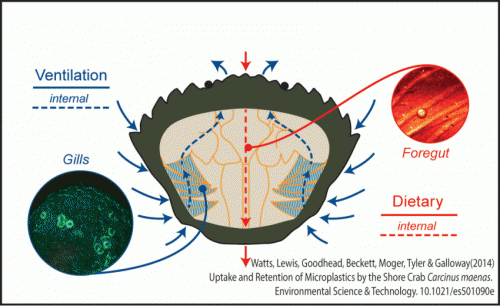The researchers used fluorescently labelled polystyrene microspheres to show how ingested microplastics were retained within the body tissues of the common shore crab, Carcinus maenas. Multiphoton imaging suggested that most microspheres were retained in the foregut after sticking to hair-like 'setae' structures within the crabs. Credit: Andrew Watts
The tiny plastic particles polluting our seas are not only orally ingested by marine creatures, but also enter their systems through their gills, according to a new study led by the University of Exeter.
Scientists also discovered that when microplastics are drawn in through this method they take over six times longer to leave the body compared with standard digestion.
Lead author Dr Andrew Watts of the University of Exeter said: "Many studies on microplastics only consider ingestion as a route of uptake into animals. The results we have just published stress other routes such as ventilation. We have shown this for crabs, but the same could apply for other crustaceans, molluscs and fish – simply any animal which draws water into a gill-like structure to carry out gas exchange.
"This is highly important from an ecological point of view, as if these plastics are retained longer within the animal there is more chance of them being passed up the food chain."
The researchers used fluorescently labelled polystyrene microspheres to show how ingested microplastics were retained within the body tissues of the common shore crab, Carcinus maenas. Multiphoton imaging suggested that most microspheres were retained in the foregut after sticking to hair-like 'setae' structures within the crabs.
This image depicts polystyrene microspheres inside the gills of a shore crab. Credit: Andrew Watts
Plastic is part of our everyday lives and has grown in use substantially over the past seven decades – from 1.7 million tonnes in 1950 to an estimated 288 million tonnes in 2013. Around 40 per cent of this is believed to come from packaging material, most of which is single use and therefore disposed of.
It has been suggested that 10 per cent of plastic which is thrown away ends up in the marine environment. At 2013 production levels this equates to 11 million tonnes of packaging ending up in the marine environment every year. This plastic is then degraded by wave action, heat or UV damage and is created into microplastic (particles smaller than 5mm).
Dr Watts added: "This is a human issue. We have put this plastic there, mostly accidently, but it is our problem to solve. The best way to do this is to reduce our dependency on plastic. It comes back to the old phrase: reduce, reuse and recycle."
The study, published in the journal Environmental Science and Technology, was funded by CleanSeas, a multidisciplinary and collaborative research project addressing marine litter from different perspectives. It aims at providing Member States and other stakeholders with improved knowledge, methods and tools to be able to better define, monitor and achieve a marine environment free of harmful litter levels by 2020 (Good Environmental Status -GES- as required by the Marine Strategy Framework Directive -MSFD). In doing so, it will deliver a set of integrated results that will provide transparent and useful guidance to policy makers and stakeholders dealing with marine litter mitigation.
Journal information: Environmental Science and Technology
Provided by University of Exeter

























